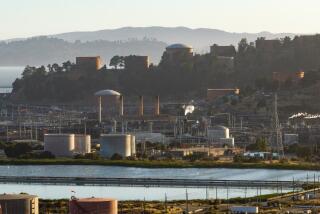State Braces for Impact of Lockheed-Martin Merger
- Share via
From factories in Palmdale and Sunnyvale to a supplier’s plant in El Monte to the Downtown Los Angeles offices of leading charities, Californians were bracing Tuesday for the fallout from Lockheed Corp.’s plans to merge with Martin Marietta Corp., creating the nation’s largest defense firm.
In formally announcing the $10-billion deal, the chief executives of the two companies predicted that some jobs will be lost as they streamline their operations. No figures on job cuts were disclosed, nor were any specific sites identified for closure.
But at a minimum, Lockheed--founded in Santa Barbara in 1916 and a cornerstone of the Southland’s aerospace industry for decades--will abandon its headquarters building in Calabasas, where 250 people work. The new Lockheed Martin Corp. will be based in Bethesda, Md., home of Martin Marietta.
The departure eastward of Lockheed’s top managers will be a “psychological blow” to the state’s already reeling aerospace business, said Richard A. Bitzinger, an analyst with the Defense Budget Project in Washington.
To be sure, Lockheed still employs 20,000 in California--mostly in the Silicon Valley, Palmdale and Ontario--and Martin Marietta has about 7,500 workers in the state. Together, those figures make California the largest job center for the new Lockheed Martin.
The deal, which requires the approval of federal antitrust regulators and the two firms’ shareholders, will create a defense giant with nearly $23 billion in annual sales. Lockheed makes jet fighters, ballistic missiles and satellites, while Martin Marietta is a leading producer of defense electronics, satellite gear and space launchers.
Lockheed Chairman Daniel M. Tellep, who is slated to become chairman of the merged company, sought Tuesday to dispel the idea that California would again be the victim of job losses resulting from a defense industry marriage.
“We have an infrastructure there,” Tellep said in an interview in New York, where the deal was announced. “I am optimistic that, other than the dislocation of the headquarters, the long-term outlook for California has to be positive as a result of this transaction.”
The reaction in California was decidedly mixed, however. Some Lockheed workers embraced the deal, saying it would help keep Lockheed strong as Pentagon spending slips further. Others worried about losing their jobs or being transferred.
Kevin Agovino, a manager at Lockheed’s 4,000-employee Skunk Works aircraft development plant in Palmdale, noted that mergers often create a duplication of effort, so “the possibility (of layoffs) always exists.”
Industry analysts said the amalgamation of the two storied firms is a symptom of ongoing changes in the defense business that have wiped out more than 300,000 aerospace-related jobs in California alone since the mid-1980s.
The root causes of those changes--upheaval and contraction in defense spending with the end of the Cold War--will further whittle California’s aerospace payroll, regardless of whether Lockheed and Martin Marietta join forces, they said.
People directly in the path of the Lockheed-Martin Marietta deal, such as parts suppliers, are having to re-evaluate their sales potential.
Sargent-Fletcher Co., an El Monte-based provider of fuel tanks and electronic products for Lockheed’s F-16 fighters, fears that Lockheed will start using Martin Marietta’s products instead, said Richard Simpson, the firm’s director of business development.
Charitable groups fretted that the loss of Lockheed’s California headquarters could slice into the largess of one of the state’s top corporate citizens.
Lockheed contributed more than $3.5 million to arts, civic and education programs in California in 1992, and the company annually has donated about $500,000 to United Way in Los Angeles County, said John Moawad, senior vice president of resource development for the charity group’s Los Angeles corporate office.
Corporate donors usually support United Way units nearest their headquarters, but Moawad said officials are hopeful Lockheed will continue supporting charities in California.
Meanwhile, small business operators who cater to Lockheed’s facilities also expressed concern that the merger might damage their sales.
At Fresh Choice, a favorite noontime restaurant for Lockheed’s Sunnyvale workers, manager Juan Mendivit said the company accounts for as much as 90% of his 450 or so customers each day. “If you lay off more,” he said, “it will definitely hurt business.”
But some aerospace analysts said the Sunnyvale operation--home of Lockheed’s missiles and spacecraft group, which employs 11,900--could realize a net gain in workers if the new Lockheed Martin decides to pare other, smaller spacecraft plants in New Jersey and Pennsylvania. (The company also would have a fourth major spacecraft site in Denver.)
Because Sunnyvale is a major employer of skilled engineers--not just production workers--its operations are less likely to be uprooted from California in pursuit of lower wage rates, said Paul Harbison, an aerospace analyst with the consulting firm Booz, Allen & Hamilton in Los Angeles.
Prospects also appear slight for Lockheed Martin moving the top-secret Skunk Works research facility out of Palmdale--at least for now. In recent years, Lockheed spent more than $200 million expanding its Palmdale facilities to accommodate the transfer of Skunk Works employees from Burbank. Martin Marietta has no similar group of workers.
Times staff writers Ralph Vartabedian in Washington, Martha Groves in Sunnyvale, Phil Sneiderman in Palmdale and Jill Leovy in Chatsworth contributed to this story.
* STORIES, GRAPHICS: D1, D3
More to Read
Inside the business of entertainment
The Wide Shot brings you news, analysis and insights on everything from streaming wars to production — and what it all means for the future.
You may occasionally receive promotional content from the Los Angeles Times.











